CMNS130A/B Essay: Transmedia Storytelling and 'Lord of the Rings'
VerifiedAdded on 2022/08/09
|7
|1854
|267
Essay
AI Summary
This essay analyzes the transmedia storytelling aspects of "The Lord of the Rings," focusing on the adaptation of J.R.R. Tolkien's novel into film and other media formats. It examines how the film trilogy, directed by Peter Jackson, successfully expanded the narrative across multiple platforms while maintaining the core story. The essay considers Henry Jenkins' principles of transmedia storytelling, highlighting how the story adapts to different mediums and contributes to a larger, cohesive narrative. It also explores the influence of ownership structures and funding models, referencing Chomsky's Propaganda Model to understand how these factors may have shaped the film's content. The analysis includes a discussion of the differences and nuances between the novel and film adaptations, emphasizing the importance of preserving the essence of the story while enhancing it for a visual medium. The essay concludes that "The Lord of the Rings" exemplifies effective transmedia storytelling by creating a universe that resonates with audiences across various platforms and generations.
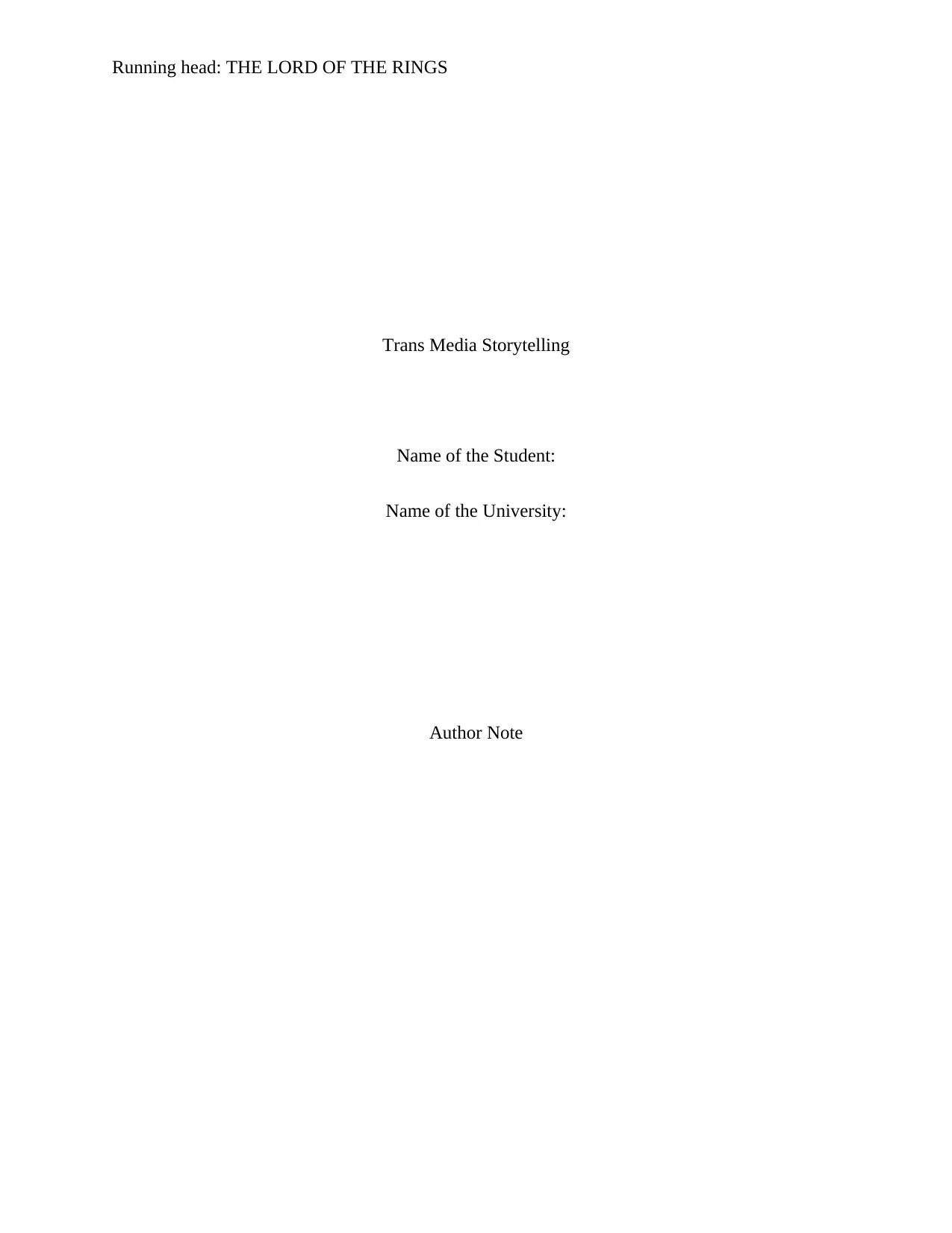
Running head: THE LORD OF THE RINGS
Trans Media Storytelling
Name of the Student:
Name of the University:
Author Note
Trans Media Storytelling
Name of the Student:
Name of the University:
Author Note
Paraphrase This Document
Need a fresh take? Get an instant paraphrase of this document with our AI Paraphraser
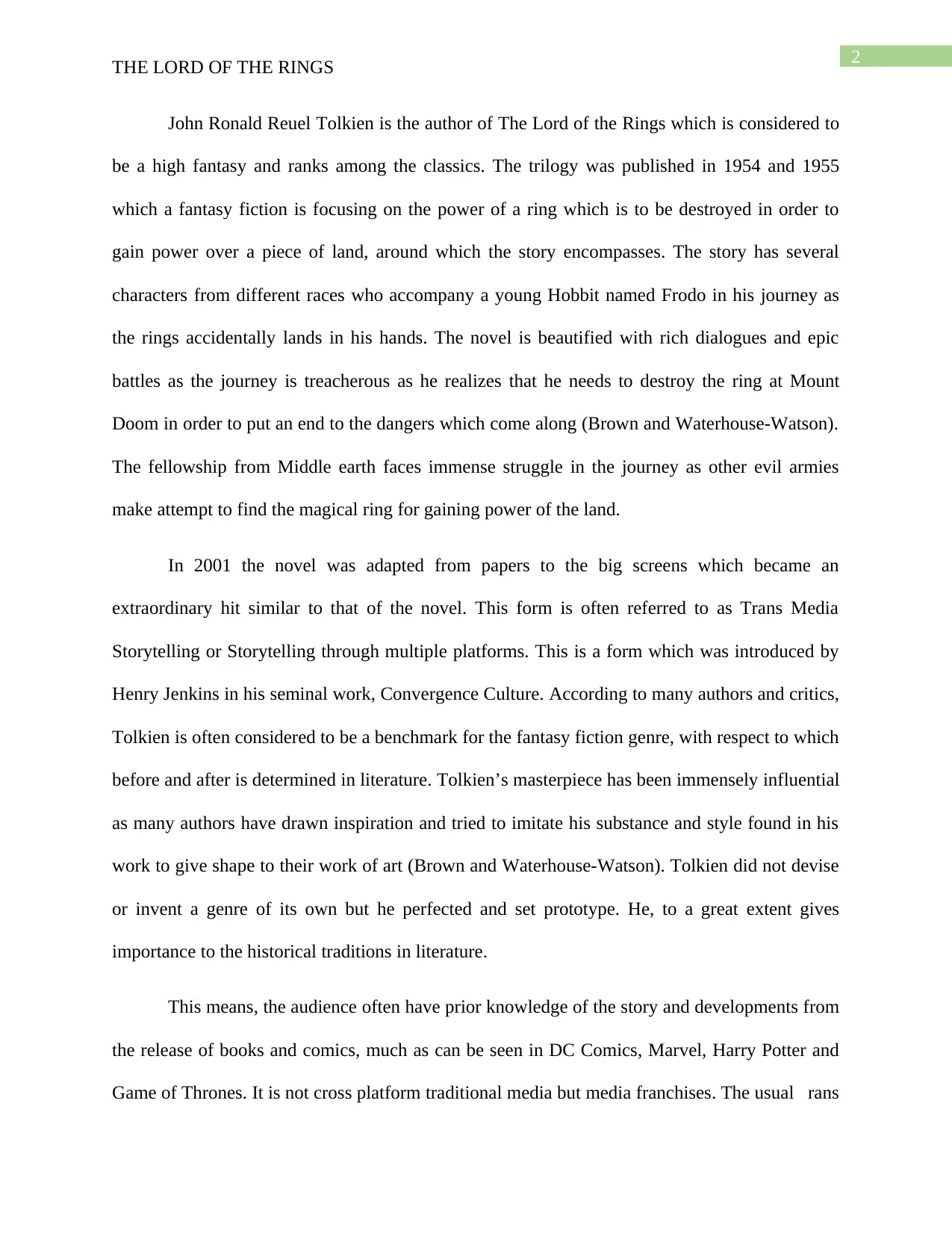
2
THE LORD OF THE RINGS
John Ronald Reuel Tolkien is the author of The Lord of the Rings which is considered to
be a high fantasy and ranks among the classics. The trilogy was published in 1954 and 1955
which a fantasy fiction is focusing on the power of a ring which is to be destroyed in order to
gain power over a piece of land, around which the story encompasses. The story has several
characters from different races who accompany a young Hobbit named Frodo in his journey as
the rings accidentally lands in his hands. The novel is beautified with rich dialogues and epic
battles as the journey is treacherous as he realizes that he needs to destroy the ring at Mount
Doom in order to put an end to the dangers which come along (Brown and Waterhouse-Watson).
The fellowship from Middle earth faces immense struggle in the journey as other evil armies
make attempt to find the magical ring for gaining power of the land.
In 2001 the novel was adapted from papers to the big screens which became an
extraordinary hit similar to that of the novel. This form is often referred to as Trans Media
Storytelling or Storytelling through multiple platforms. This is a form which was introduced by
Henry Jenkins in his seminal work, Convergence Culture. According to many authors and critics,
Tolkien is often considered to be a benchmark for the fantasy fiction genre, with respect to which
before and after is determined in literature. Tolkien’s masterpiece has been immensely influential
as many authors have drawn inspiration and tried to imitate his substance and style found in his
work to give shape to their work of art (Brown and Waterhouse-Watson). Tolkien did not devise
or invent a genre of its own but he perfected and set prototype. He, to a great extent gives
importance to the historical traditions in literature.
This means, the audience often have prior knowledge of the story and developments from
the release of books and comics, much as can be seen in DC Comics, Marvel, Harry Potter and
Game of Thrones. It is not cross platform traditional media but media franchises. The usual rans
THE LORD OF THE RINGS
John Ronald Reuel Tolkien is the author of The Lord of the Rings which is considered to
be a high fantasy and ranks among the classics. The trilogy was published in 1954 and 1955
which a fantasy fiction is focusing on the power of a ring which is to be destroyed in order to
gain power over a piece of land, around which the story encompasses. The story has several
characters from different races who accompany a young Hobbit named Frodo in his journey as
the rings accidentally lands in his hands. The novel is beautified with rich dialogues and epic
battles as the journey is treacherous as he realizes that he needs to destroy the ring at Mount
Doom in order to put an end to the dangers which come along (Brown and Waterhouse-Watson).
The fellowship from Middle earth faces immense struggle in the journey as other evil armies
make attempt to find the magical ring for gaining power of the land.
In 2001 the novel was adapted from papers to the big screens which became an
extraordinary hit similar to that of the novel. This form is often referred to as Trans Media
Storytelling or Storytelling through multiple platforms. This is a form which was introduced by
Henry Jenkins in his seminal work, Convergence Culture. According to many authors and critics,
Tolkien is often considered to be a benchmark for the fantasy fiction genre, with respect to which
before and after is determined in literature. Tolkien’s masterpiece has been immensely influential
as many authors have drawn inspiration and tried to imitate his substance and style found in his
work to give shape to their work of art (Brown and Waterhouse-Watson). Tolkien did not devise
or invent a genre of its own but he perfected and set prototype. He, to a great extent gives
importance to the historical traditions in literature.
This means, the audience often have prior knowledge of the story and developments from
the release of books and comics, much as can be seen in DC Comics, Marvel, Harry Potter and
Game of Thrones. It is not cross platform traditional media but media franchises. The usual rans
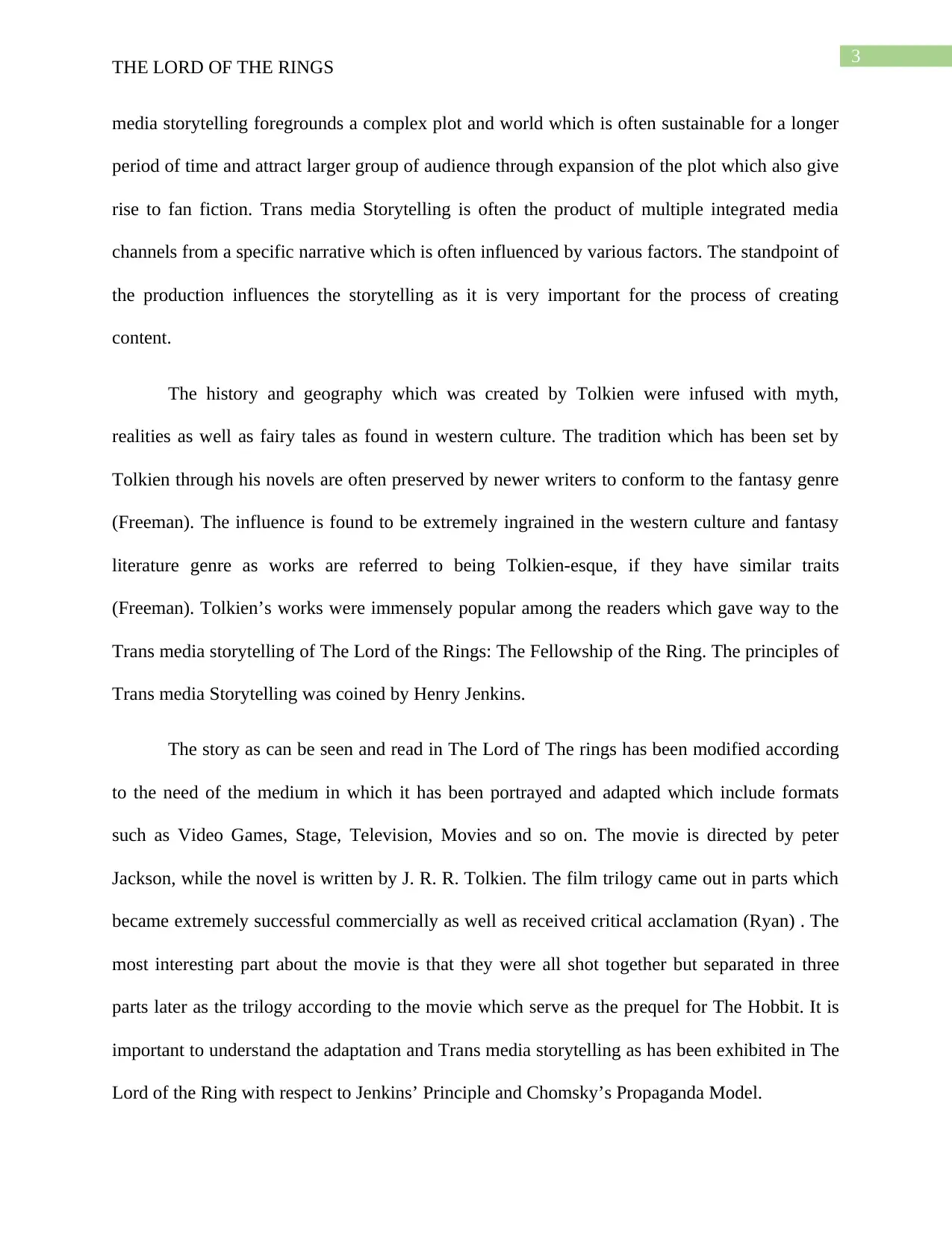
3
THE LORD OF THE RINGS
media storytelling foregrounds a complex plot and world which is often sustainable for a longer
period of time and attract larger group of audience through expansion of the plot which also give
rise to fan fiction. Trans media Storytelling is often the product of multiple integrated media
channels from a specific narrative which is often influenced by various factors. The standpoint of
the production influences the storytelling as it is very important for the process of creating
content.
The history and geography which was created by Tolkien were infused with myth,
realities as well as fairy tales as found in western culture. The tradition which has been set by
Tolkien through his novels are often preserved by newer writers to conform to the fantasy genre
(Freeman). The influence is found to be extremely ingrained in the western culture and fantasy
literature genre as works are referred to being Tolkien-esque, if they have similar traits
(Freeman). Tolkien’s works were immensely popular among the readers which gave way to the
Trans media storytelling of The Lord of the Rings: The Fellowship of the Ring. The principles of
Trans media Storytelling was coined by Henry Jenkins.
The story as can be seen and read in The Lord of The rings has been modified according
to the need of the medium in which it has been portrayed and adapted which include formats
such as Video Games, Stage, Television, Movies and so on. The movie is directed by peter
Jackson, while the novel is written by J. R. R. Tolkien. The film trilogy came out in parts which
became extremely successful commercially as well as received critical acclamation (Ryan) . The
most interesting part about the movie is that they were all shot together but separated in three
parts later as the trilogy according to the movie which serve as the prequel for The Hobbit. It is
important to understand the adaptation and Trans media storytelling as has been exhibited in The
Lord of the Ring with respect to Jenkins’ Principle and Chomsky’s Propaganda Model.
THE LORD OF THE RINGS
media storytelling foregrounds a complex plot and world which is often sustainable for a longer
period of time and attract larger group of audience through expansion of the plot which also give
rise to fan fiction. Trans media Storytelling is often the product of multiple integrated media
channels from a specific narrative which is often influenced by various factors. The standpoint of
the production influences the storytelling as it is very important for the process of creating
content.
The history and geography which was created by Tolkien were infused with myth,
realities as well as fairy tales as found in western culture. The tradition which has been set by
Tolkien through his novels are often preserved by newer writers to conform to the fantasy genre
(Freeman). The influence is found to be extremely ingrained in the western culture and fantasy
literature genre as works are referred to being Tolkien-esque, if they have similar traits
(Freeman). Tolkien’s works were immensely popular among the readers which gave way to the
Trans media storytelling of The Lord of the Rings: The Fellowship of the Ring. The principles of
Trans media Storytelling was coined by Henry Jenkins.
The story as can be seen and read in The Lord of The rings has been modified according
to the need of the medium in which it has been portrayed and adapted which include formats
such as Video Games, Stage, Television, Movies and so on. The movie is directed by peter
Jackson, while the novel is written by J. R. R. Tolkien. The film trilogy came out in parts which
became extremely successful commercially as well as received critical acclamation (Ryan) . The
most interesting part about the movie is that they were all shot together but separated in three
parts later as the trilogy according to the movie which serve as the prequel for The Hobbit. It is
important to understand the adaptation and Trans media storytelling as has been exhibited in The
Lord of the Ring with respect to Jenkins’ Principle and Chomsky’s Propaganda Model.
⊘ This is a preview!⊘
Do you want full access?
Subscribe today to unlock all pages.

Trusted by 1+ million students worldwide
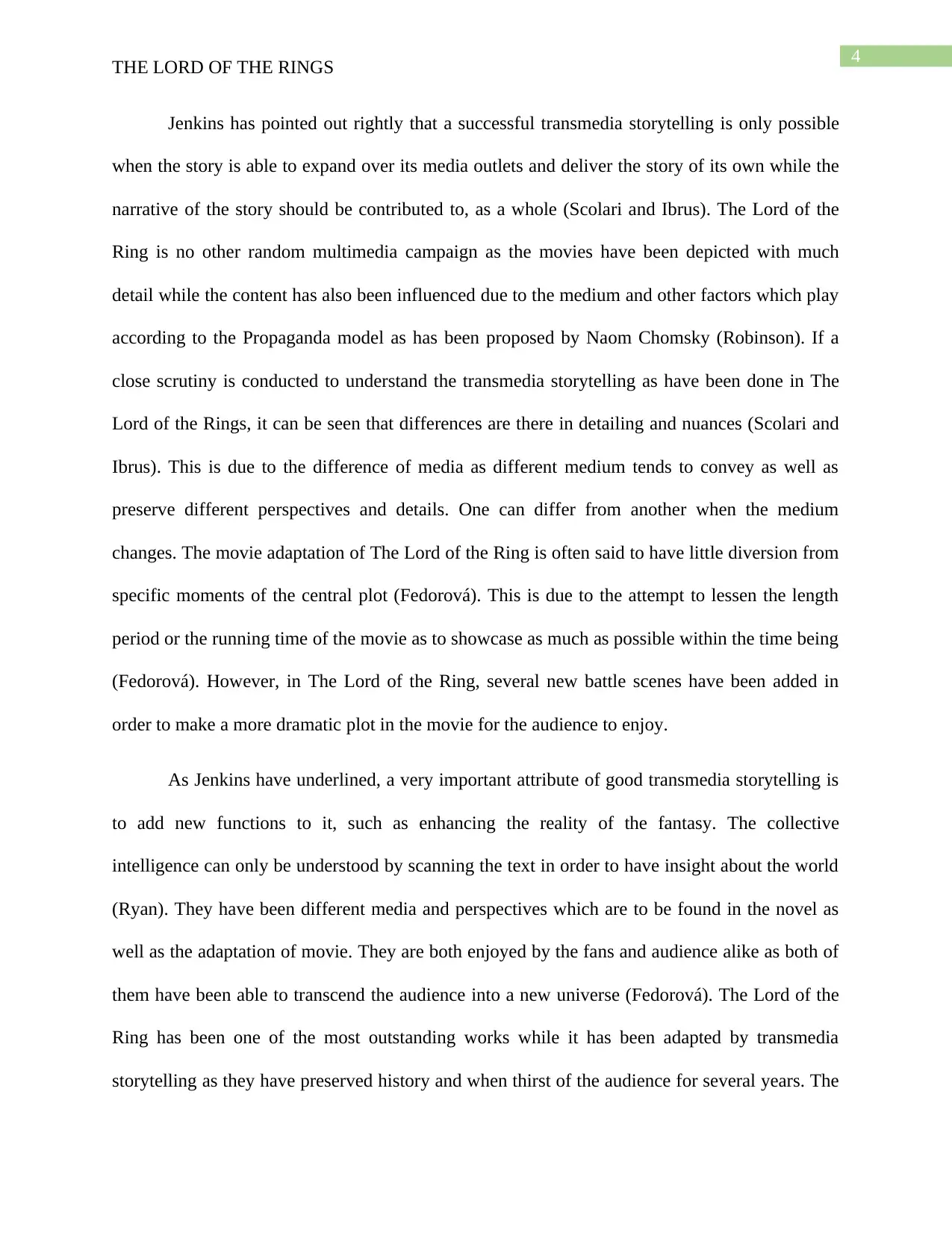
4
THE LORD OF THE RINGS
Jenkins has pointed out rightly that a successful transmedia storytelling is only possible
when the story is able to expand over its media outlets and deliver the story of its own while the
narrative of the story should be contributed to, as a whole (Scolari and Ibrus). The Lord of the
Ring is no other random multimedia campaign as the movies have been depicted with much
detail while the content has also been influenced due to the medium and other factors which play
according to the Propaganda model as has been proposed by Naom Chomsky (Robinson). If a
close scrutiny is conducted to understand the transmedia storytelling as have been done in The
Lord of the Rings, it can be seen that differences are there in detailing and nuances (Scolari and
Ibrus). This is due to the difference of media as different medium tends to convey as well as
preserve different perspectives and details. One can differ from another when the medium
changes. The movie adaptation of The Lord of the Ring is often said to have little diversion from
specific moments of the central plot (Fedorová). This is due to the attempt to lessen the length
period or the running time of the movie as to showcase as much as possible within the time being
(Fedorová). However, in The Lord of the Ring, several new battle scenes have been added in
order to make a more dramatic plot in the movie for the audience to enjoy.
As Jenkins have underlined, a very important attribute of good transmedia storytelling is
to add new functions to it, such as enhancing the reality of the fantasy. The collective
intelligence can only be understood by scanning the text in order to have insight about the world
(Ryan). They have been different media and perspectives which are to be found in the novel as
well as the adaptation of movie. They are both enjoyed by the fans and audience alike as both of
them have been able to transcend the audience into a new universe (Fedorová). The Lord of the
Ring has been one of the most outstanding works while it has been adapted by transmedia
storytelling as they have preserved history and when thirst of the audience for several years. The
THE LORD OF THE RINGS
Jenkins has pointed out rightly that a successful transmedia storytelling is only possible
when the story is able to expand over its media outlets and deliver the story of its own while the
narrative of the story should be contributed to, as a whole (Scolari and Ibrus). The Lord of the
Ring is no other random multimedia campaign as the movies have been depicted with much
detail while the content has also been influenced due to the medium and other factors which play
according to the Propaganda model as has been proposed by Naom Chomsky (Robinson). If a
close scrutiny is conducted to understand the transmedia storytelling as have been done in The
Lord of the Rings, it can be seen that differences are there in detailing and nuances (Scolari and
Ibrus). This is due to the difference of media as different medium tends to convey as well as
preserve different perspectives and details. One can differ from another when the medium
changes. The movie adaptation of The Lord of the Ring is often said to have little diversion from
specific moments of the central plot (Fedorová). This is due to the attempt to lessen the length
period or the running time of the movie as to showcase as much as possible within the time being
(Fedorová). However, in The Lord of the Ring, several new battle scenes have been added in
order to make a more dramatic plot in the movie for the audience to enjoy.
As Jenkins have underlined, a very important attribute of good transmedia storytelling is
to add new functions to it, such as enhancing the reality of the fantasy. The collective
intelligence can only be understood by scanning the text in order to have insight about the world
(Ryan). They have been different media and perspectives which are to be found in the novel as
well as the adaptation of movie. They are both enjoyed by the fans and audience alike as both of
them have been able to transcend the audience into a new universe (Fedorová). The Lord of the
Ring has been one of the most outstanding works while it has been adapted by transmedia
storytelling as they have preserved history and when thirst of the audience for several years. The
Paraphrase This Document
Need a fresh take? Get an instant paraphrase of this document with our AI Paraphraser
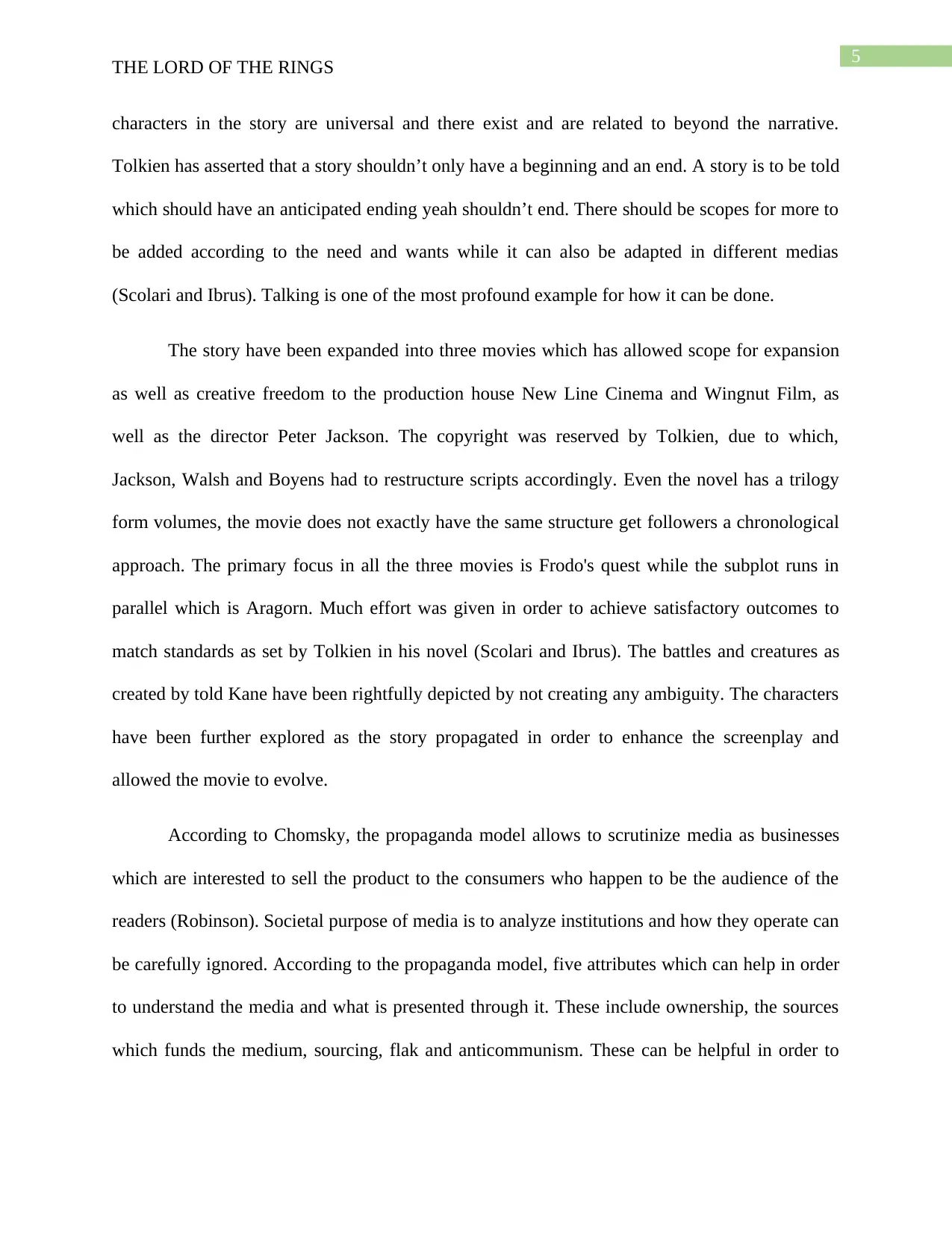
5
THE LORD OF THE RINGS
characters in the story are universal and there exist and are related to beyond the narrative.
Tolkien has asserted that a story shouldn’t only have a beginning and an end. A story is to be told
which should have an anticipated ending yeah shouldn’t end. There should be scopes for more to
be added according to the need and wants while it can also be adapted in different medias
(Scolari and Ibrus). Talking is one of the most profound example for how it can be done.
The story have been expanded into three movies which has allowed scope for expansion
as well as creative freedom to the production house New Line Cinema and Wingnut Film, as
well as the director Peter Jackson. The copyright was reserved by Tolkien, due to which,
Jackson, Walsh and Boyens had to restructure scripts accordingly. Even the novel has a trilogy
form volumes, the movie does not exactly have the same structure get followers a chronological
approach. The primary focus in all the three movies is Frodo's quest while the subplot runs in
parallel which is Aragorn. Much effort was given in order to achieve satisfactory outcomes to
match standards as set by Tolkien in his novel (Scolari and Ibrus). The battles and creatures as
created by told Kane have been rightfully depicted by not creating any ambiguity. The characters
have been further explored as the story propagated in order to enhance the screenplay and
allowed the movie to evolve.
According to Chomsky, the propaganda model allows to scrutinize media as businesses
which are interested to sell the product to the consumers who happen to be the audience of the
readers (Robinson). Societal purpose of media is to analyze institutions and how they operate can
be carefully ignored. According to the propaganda model, five attributes which can help in order
to understand the media and what is presented through it. These include ownership, the sources
which funds the medium, sourcing, flak and anticommunism. These can be helpful in order to
THE LORD OF THE RINGS
characters in the story are universal and there exist and are related to beyond the narrative.
Tolkien has asserted that a story shouldn’t only have a beginning and an end. A story is to be told
which should have an anticipated ending yeah shouldn’t end. There should be scopes for more to
be added according to the need and wants while it can also be adapted in different medias
(Scolari and Ibrus). Talking is one of the most profound example for how it can be done.
The story have been expanded into three movies which has allowed scope for expansion
as well as creative freedom to the production house New Line Cinema and Wingnut Film, as
well as the director Peter Jackson. The copyright was reserved by Tolkien, due to which,
Jackson, Walsh and Boyens had to restructure scripts accordingly. Even the novel has a trilogy
form volumes, the movie does not exactly have the same structure get followers a chronological
approach. The primary focus in all the three movies is Frodo's quest while the subplot runs in
parallel which is Aragorn. Much effort was given in order to achieve satisfactory outcomes to
match standards as set by Tolkien in his novel (Scolari and Ibrus). The battles and creatures as
created by told Kane have been rightfully depicted by not creating any ambiguity. The characters
have been further explored as the story propagated in order to enhance the screenplay and
allowed the movie to evolve.
According to Chomsky, the propaganda model allows to scrutinize media as businesses
which are interested to sell the product to the consumers who happen to be the audience of the
readers (Robinson). Societal purpose of media is to analyze institutions and how they operate can
be carefully ignored. According to the propaganda model, five attributes which can help in order
to understand the media and what is presented through it. These include ownership, the sources
which funds the medium, sourcing, flak and anticommunism. These can be helpful in order to
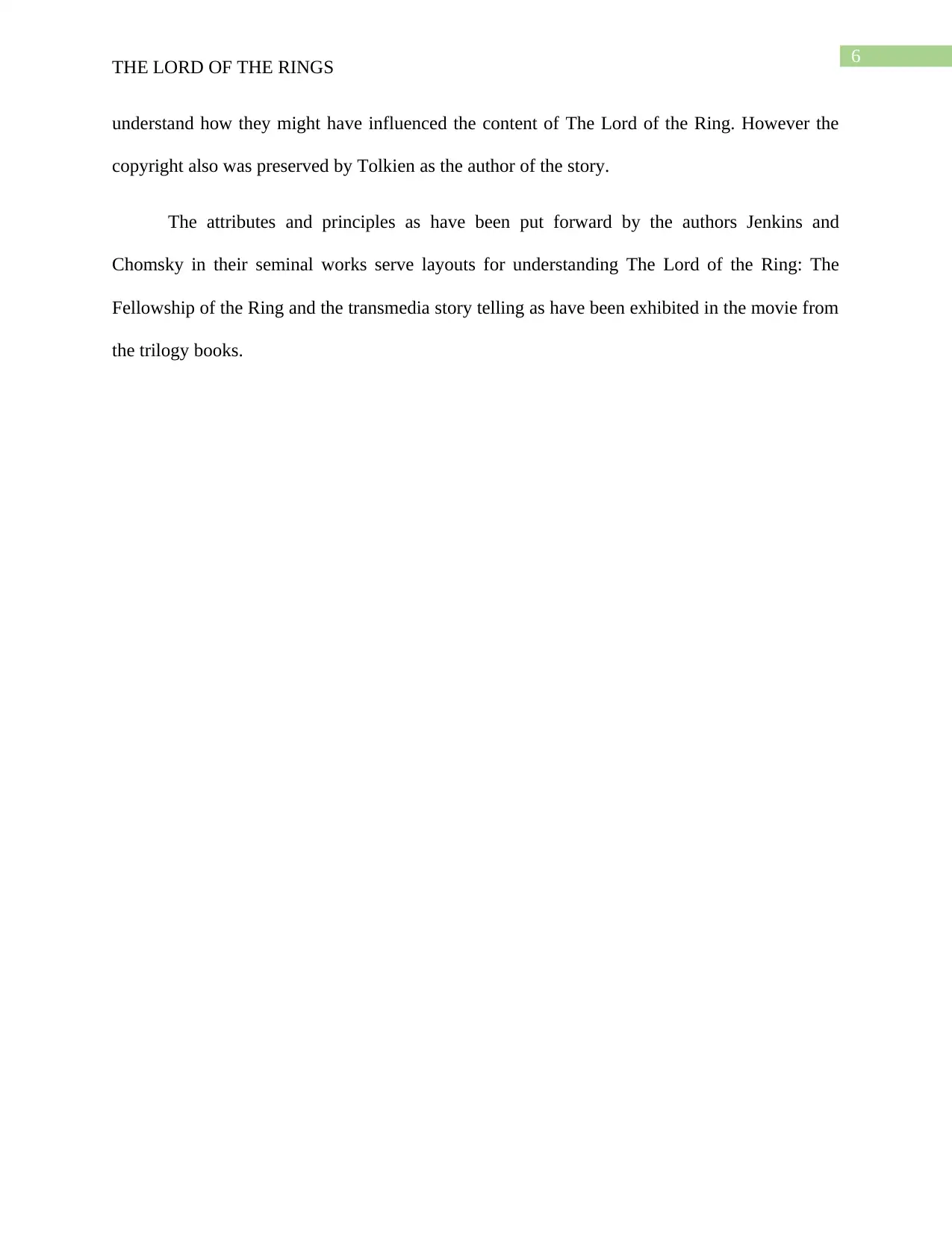
6
THE LORD OF THE RINGS
understand how they might have influenced the content of The Lord of the Ring. However the
copyright also was preserved by Tolkien as the author of the story.
The attributes and principles as have been put forward by the authors Jenkins and
Chomsky in their seminal works serve layouts for understanding The Lord of the Ring: The
Fellowship of the Ring and the transmedia story telling as have been exhibited in the movie from
the trilogy books.
THE LORD OF THE RINGS
understand how they might have influenced the content of The Lord of the Ring. However the
copyright also was preserved by Tolkien as the author of the story.
The attributes and principles as have been put forward by the authors Jenkins and
Chomsky in their seminal works serve layouts for understanding The Lord of the Ring: The
Fellowship of the Ring and the transmedia story telling as have been exhibited in the movie from
the trilogy books.
⊘ This is a preview!⊘
Do you want full access?
Subscribe today to unlock all pages.

Trusted by 1+ million students worldwide
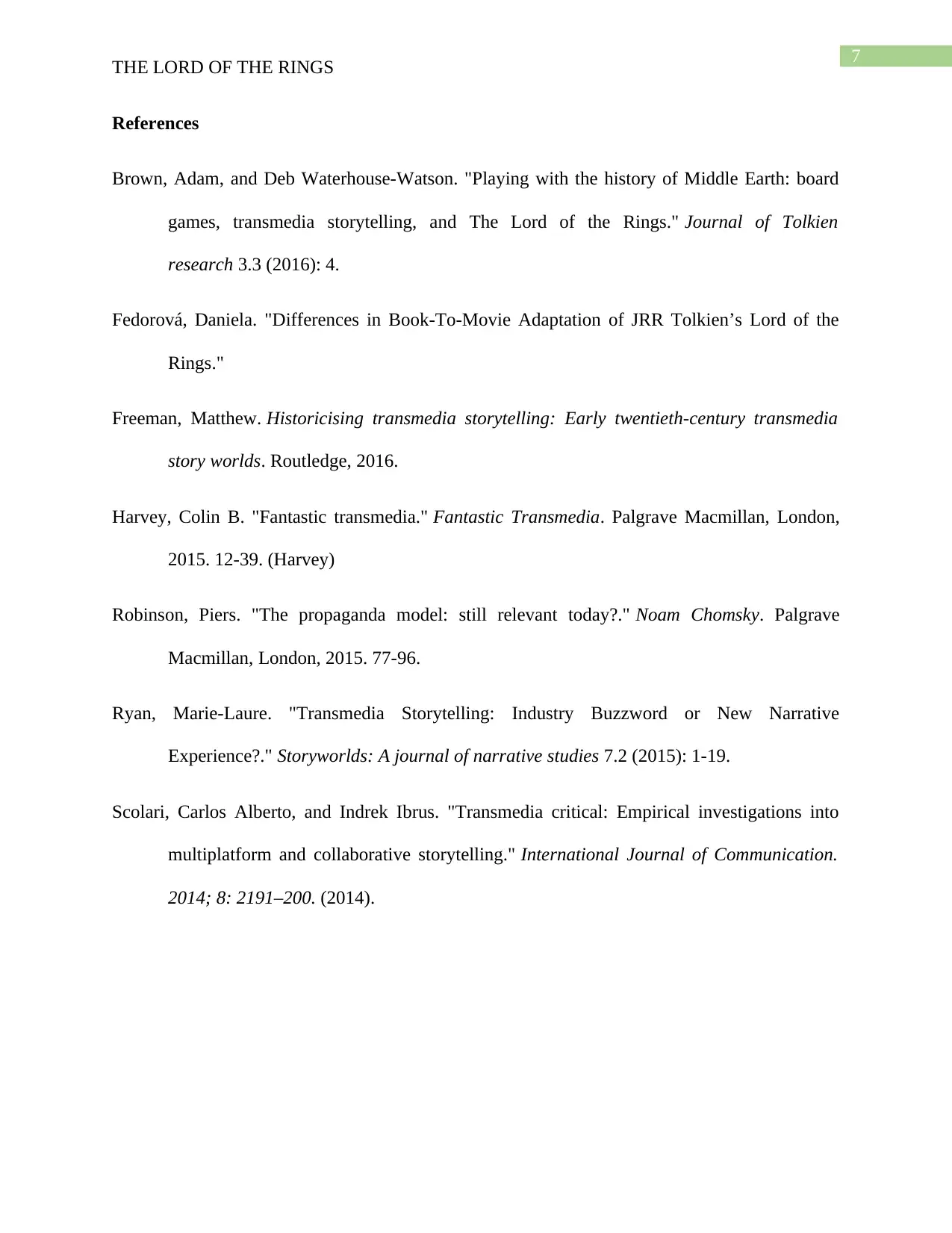
7
THE LORD OF THE RINGS
References
Brown, Adam, and Deb Waterhouse-Watson. "Playing with the history of Middle Earth: board
games, transmedia storytelling, and The Lord of the Rings." Journal of Tolkien
research 3.3 (2016): 4.
Fedorová, Daniela. "Differences in Book-To-Movie Adaptation of JRR Tolkien’s Lord of the
Rings."
Freeman, Matthew. Historicising transmedia storytelling: Early twentieth-century transmedia
story worlds. Routledge, 2016.
Harvey, Colin B. "Fantastic transmedia." Fantastic Transmedia. Palgrave Macmillan, London,
2015. 12-39. (Harvey)
Robinson, Piers. "The propaganda model: still relevant today?." Noam Chomsky. Palgrave
Macmillan, London, 2015. 77-96.
Ryan, Marie-Laure. "Transmedia Storytelling: Industry Buzzword or New Narrative
Experience?." Storyworlds: A journal of narrative studies 7.2 (2015): 1-19.
Scolari, Carlos Alberto, and Indrek Ibrus. "Transmedia critical: Empirical investigations into
multiplatform and collaborative storytelling." International Journal of Communication.
2014; 8: 2191–200. (2014).
THE LORD OF THE RINGS
References
Brown, Adam, and Deb Waterhouse-Watson. "Playing with the history of Middle Earth: board
games, transmedia storytelling, and The Lord of the Rings." Journal of Tolkien
research 3.3 (2016): 4.
Fedorová, Daniela. "Differences in Book-To-Movie Adaptation of JRR Tolkien’s Lord of the
Rings."
Freeman, Matthew. Historicising transmedia storytelling: Early twentieth-century transmedia
story worlds. Routledge, 2016.
Harvey, Colin B. "Fantastic transmedia." Fantastic Transmedia. Palgrave Macmillan, London,
2015. 12-39. (Harvey)
Robinson, Piers. "The propaganda model: still relevant today?." Noam Chomsky. Palgrave
Macmillan, London, 2015. 77-96.
Ryan, Marie-Laure. "Transmedia Storytelling: Industry Buzzword or New Narrative
Experience?." Storyworlds: A journal of narrative studies 7.2 (2015): 1-19.
Scolari, Carlos Alberto, and Indrek Ibrus. "Transmedia critical: Empirical investigations into
multiplatform and collaborative storytelling." International Journal of Communication.
2014; 8: 2191–200. (2014).
1 out of 7
Your All-in-One AI-Powered Toolkit for Academic Success.
+13062052269
info@desklib.com
Available 24*7 on WhatsApp / Email
![[object Object]](/_next/static/media/star-bottom.7253800d.svg)
Unlock your academic potential
Copyright © 2020–2025 A2Z Services. All Rights Reserved. Developed and managed by ZUCOL.

